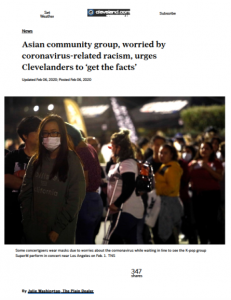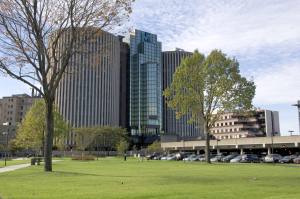By Joshua Beltran, Research Assistant, Center for Health Equity Engagement Education and Research
As the COVID-19 (coronavirus) pandemic started to make its way to various parts of the United States this article caught my attention. It discusses a rise in racial discrimination against Asians, with some people believing, incorrectly, that this group is more susceptible to carrying, therefore spreading, the virus. This belief led to people boycotting Asian based establishments and other similar behaviors. A local Asian community group voiced their concern for these actions and urged people to discern facts from myth. These acts of racism became so prevalent that the Center for Disease Control (CDC) had to issue a statement on their website dispelling the idea of Asians, or any ethnic group, having an increased susceptibility to coronavirus. The article brought to my attention a history rooted in myth that I wasn’t aware of, yet am unsurprised about. Being of Asian descent myself, this type of mentality hits close to home. The idea that Asians harbor disease is a myth that, due to the pandemic, is being fueled once again. However, this isn’t the first time this myth has been used as a scapegoat in this fashion. All stereotypes have an origin and persist over time because of situations such as the coronavirus pandemic. In order to stop this stereotype from continuing, I thought this would be a good time to briefly review its history, origin, and how it’s been perpetuated over the years. I firmly believe in the idea that without learning from mistakes of the past, we are bound to repeat them in the future.
The myth that Asians harbor disease can trace its root back to the 1800’s when there was a large increase in Chinese immigration into San Francisco, California. This influx was due to the Gold Rush in the west. Like many anti-immigration sentiments, there was a backlash from white labor unions concerned for job availability. In an effort to bar Chinese people from entering the U.S. rumors began to circulate that the Chinese people harbor disease. Some argue that Chinese strains of certain maladies, especially sexually transmitted infections, are more virulent than the American strains. However, these accusations would have little ground to stand on if it weren’t for the fact that influential physicians of the time lent their voice to the argument. Figures such as a city health official named Dr. John L. Meares who made claims that leprosy was Chinese disease that was the result of “generations of syphilis” culminating. Another example is Dr. Arthur B. Stout who wrote a pamphlet titled, Chinese Immigration and the Physiological Causes of the Decay of the Nation. The pamphlet, makes note of a connection between syphilis and the Chinese people. Following this, another doctor named Dr. Hugh Toland was inspired by Stout’s work and testified during a California State senate hearing in 1876. Dr. Toland’s testimony claimed that syphilis contracted from Chinese woman was more contagious and harder treat than its American counterpart. This testimony appeared in various places, one of which being the Medico-Literary Journal of San Francisco in 1878, the headline read How the Chinese Women are Infusing a Poison into the Anglo-Saxon Blood. It is important to mention that these statements were made by what were considered as one source claims as “they were the pillars of white liberal society.” This claim isn’t far-fetched as it seems considering that Dr. Toland was member of the health board of San Francisco and the founder of Toland Medical College which he transferred as a gift to the University of California, San Francisco. Also, the editor of the journal was M.P. Sawtelle who was a leading feminist and one of the first women on the west coast to attend medical school, as well as an early suffragist.
This origin on its own can only get so far, as I mentioned the coronavirus isn’t the first time this myth has reared its ugly head. In 1900 a case of bubonic plague hit San Francisco, which was most likely triggered by a rat onboard a ship from China. This is believed because the same type of plague had an outbreak in the southern Chinese trading city of Guangzhou in the 1870’s. Initially California’s governor at the time quarantined San Francisco’s Chinatown but the lifted the blockade following concerns that the new would negatively affect California’s fruit exports to the rest of the country. Following the great San Francisco earthquake of 1906 had an after effect of lingering disease. This continued presence of disease led to anti-Chinese political factions having an excuse to lobby against the rebuilding of Chinatown. Similarly, the SARS outbreak from 17 years ago, mirrors a lot of the sentiment that Chinese people are facing today during the coronavirus pandemic. I know it’s difficult for stereotypes to be dismissed but I think if we understand the history of them and how they’re based on misconception we can realize how illogical it is to believe the myth. I hope that years from now we’ll look back at this time and learn from past mistakes.
Sources:
Asian Community Group, Worried by Coronavirus-related Racism, Urges Clevelanders to ‘Get the Facts’
The Coronavirus Reawakens Old Racist Tropes Against Chinese People
The Foreignness of Germs: The Persistent Association of Immigrants and Disease in American Society
Chinese San Francisco, 1850-1943: A Trans-Pacific Community, by Yong Chen
The Beautiful Country and the Middle Kingdom: America and China, 1776 to the present, by John Pomfret

